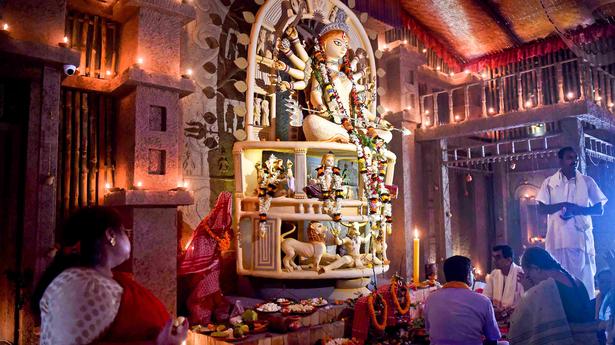
Understanding the Durga Puja economy
The Hindu
Brisker Puja sales may not implicate a better economic climate in West Bengal
There is added enthusiasm in the celebration of Kolkata’s Durga Puja after its inclusion as the 14th entry from India in UNESCO’s ‘Representative List of Intangible Cultural Heritage of Humanity’ last December. But like most major festivals, Durga Puja is not just a cultural extravaganza; it is an economic lifeline for West Bengal.
But do we have reasons to be rejuvenated? Durga Puja is a gigantic event and an opportunity for millions to earn their livelihood. People spend generously by shopping, eating out and travelling. Annual festivities like the Rio Carnival, Japan’s Hanami, Munich’s Oktoberfest and Pamplona’s San Fermín and New Orleans’ Mardi Gras festival are estimated to contribute 1.35%-2.25% of the GDP to the corresponding economies. What about Durga Puja?
Unfortunately, there are scanty studies to estimate the Durga Puja economy due to its multidimensional character. Activities go on through the year and include a mind-boggling combination of festivity, artistry, culture, entertainment, shopping, and food and drink. This makes the Puja truly unique. A 2013 ASSOCHAM study estimated the size of the Durga Puja industry at ₹25,000 crore, around 3.7% of West Bengal’s GDP at that time. And it projected a compound annual growth rate (CAGR) of about 35%, which was much higher than that of West Bengal’s GDP. Understandably, such a huge CAGR is unlikely to continue for long. Also, we had the pandemic ravaging the world in between. So, it is never easy to quantify today’s Puja economy.
A recent British Council study focused on 10 creative industries and indicated that a ₹32,377 crore creative economy, accounting for 2.58% of the State GDP, was generated during the 2019 Durga Puja in West Bengal. But this may be a much-curtailed picture — the study itself points to several sectors such as the unorganised retail market that “will add to creative worth” significantly.
In the past too, Durga Puja was affected by socio-economic-political shocks. When Bengal was ravaged by a terrible famine in 1943, the editorial of the Bengali Saradiya (Puja Special) Anandabazar wrote: “The mother who is Annapurna, the goddess of plenty and always full, she has in the guise of a beggar woman with a begging bowl in her hand has today come at your door.” A much-cited article titled ‘Economics of the Durga Puja’, published in the Economic Weekly (now Economic and Political Weekly) in October 1954, portrayed a Puja environment amid a distressed economic condition. There was a flood in northern West Bengal and a drought in the south, and workers and clerks of Kolkata staged demonstrations for a Puja bonus while they didn’t receive their September wages and salaries.
In 2020-21, the idol-making industry was in the doldrums, the lighting industry faced a power cut, and the retail market experienced a pandemic lull. But now, the Durga Puja frenzy is back. With renewed enthusiasm, can West Bengal hope for a strong comeback riding on the festive season?
In the Economic Weekly article, Puja sales were portrayed as one of the most reliable criteria for gauging the incomes of the people, although statisticians and economists might prefer other sophisticated indices. Today, a ‘K’-shaped post-pandemic economic recovery is envisaged by different experts. While millions are coping with either job loss or wage cuts, those who remained well-off during the pandemic but couldn’t spend handsomely during the last two Pujas due to pandemic restrictions might make that up considerably by their spending. And that might help people lying in the lower hand of ‘K’ as well. But overall, in an increasingly uneven world, brisker Puja sales may not implicate a better economic climate in Bengal. As the seven-decade-old Economic Weekly article warned, better Puja shopping one year compared to the previous year might, indeed, be a sad reflection of the poor income of the average Bengali. However, while a burst of discretionary spending for costly items is likely, there might be a boost in the informal economy as well, simply due to the fact that a large section of society, belonging to the lower hand of ‘K’, might want to avoid items of the formal sector that need GST, etc.. That’s the Puja magic, for the time being.













